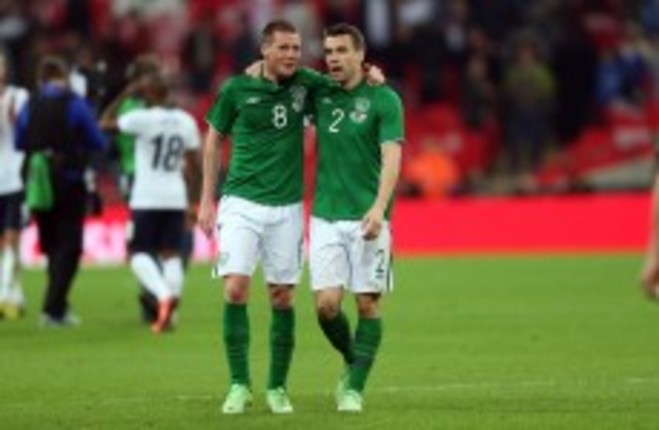GIOVANNI TRAPATTONI’S IRELAND side battled to a 1-1 draw with England last night. Here’s what we can take from the performance.
The good
- The result. This was no moral victory of old. It was a genuinely respectable draw away to one of the top 10 international sides around. No, England are not world-beaters or potential World Cup winners but their fundamental quality is high and their own desire in winning this game was revealed with the increased pressure of the final 15 minutes. Having put it up to them, Ireland held on. A draw at Wembley is not to be dismissed, regardless of the context.
- speaking of that context, this was an eminently enjoyable atmosphere. As Robbie Keane referenced beforehand, it may even reflect a healthier rivalry between the two countries. Beyond a few scattered boos for James McClean, there was barely a hint of ‘No Surrender’ and plenty of respect for the anthems. Chants like ‘you’re supposed to be at home’ were borne of friendly mischief rather than any malice.
- the charge of electricity that went around the ground as Shane Long powered that header into the net. For a few minutes, it seemed Ireland might have been on the verge of something a little special that transcended the status of a friendly game.
- the quality of that header itself. You will not see many better in the air.
- the manner in which Seamus Coleman and Long combined for such a moment of technical excellence also illustrated their obvious importance to the team. Along with James McCarthy, they were the finest performers of the night and proved their status as the side’s new core. This was the kind of thing people were railing about when Giovanni Trapattoni was neglecting them for so long.
- as a consequence of that new core, Ireland also continued to play this more progressive game than during the 2008-11 period. It was also positive that, as that perseveres, so did Trapattoni’s capacity for claiming good results away from home.
- the performance of David Forde, and especially that late one-on-one against Alex Oxlade-Chamberlain.
The bad
- the failure to hold on to that lead. Ireland did have the chance to turn a positive occasion into something to really remember.
- that inability was a result of a defensive rawness. By the time Frank Lampard got his touch on that 29th international goal, there were seven Irish defenders in the box. It was atrociously slack marking that wouldn’t have been seen in the first three years of the manager’s reign. In that, there’s also perhaps an unfortunate irony for Trapattoni. Just as he starts to develop the attacking side of the team, he loses the dependability of his backline.
- while Trapattoni now deserves credit for belatedly but relatively successfully introducing that new nucleus, the ongoing treatment of Wesley Hoolahan is odd. His introduction last night would not only have allowed Ireland to better keep the ball against a one-dimensional England, it would have provided the player with a significant boost in international terms. You could understand him getting a bit agitated with it all.
- on that note, some of the manager’s substitutions in general continue to be surprising.
- Robbie Keane is a fine figurehead who ‘gets’ occasions like that and may well be a productive impact sub, but he no longer has the energy to lead the line.

